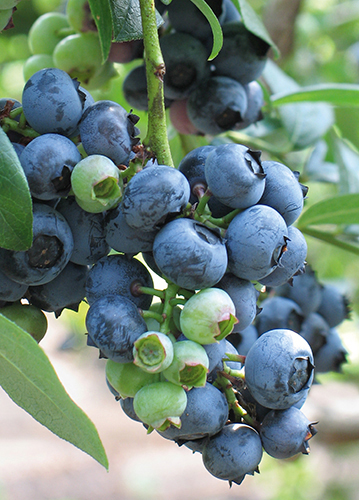
Strawberries can be grown in almost any climate and give a quicker return than any other fruit. Small berry and currant bushes grow best in cool climates, tolerate a wide range of soil conditions and thrive in a partly sunny garden sheltered from the wind.
Berry and currant plants can be grown as bushes or on supports, but will do best in a moist, well-drained soil. Strawberries can be grown in pots and hanging baskets as well as the traditional strawberry patch.
BLUEBERRIES are rich in DISEASE-FIGHTING antioxidants.
• Strawberries can be planted in beds between mid-autumn and late winter. Don’t plant them too deeply—set the crown (the boundary between the roots and the leaves) just above ground level.
• Plant bare-root berry bushes such as raspberries in autumn or as soon as you can work the ground in spring so that the plants are well established before hot weather arrives. Plant on a cloudy day or late in the afternoon.
• Plant berry plants in pots at any time, as long as you can work the soil and keep them watered during hot or dry spells. However, bushes root better when they are planted in the autumn or spring.
• Remove perennial weeds before you plant—they can rob the soil of essential water and nutrients.
• Plant the rootball of a currant bush around 3–31/2 inches (7–8 cm) below the ground surface to encourage strong growth at the base of the plant.
• Put a little rock dust in the hole along with the compost for a red currant bush to add essential trace elements and boost pest resistance. You can buy it at good garden centers or online. The sprigs should be bare of leaves to a height of about 6 inches (15 cm) above the surface of the ground.
• Leave enough space between plants to assure that they will thrive without competition. This also prevents gray mold during rainy summers.
• Renew strawberry plants every 2–3 years, choosing a fresh site. Runners from parent plants can be used to raise new plants in late summer.
• Blueberries need acid soil to thrive. Incorporate organic matter into the soil before planting to ensure strong growth. Good options include well-rotted manure, straw, compost or aged sawdust. If the soil is alkaline, it is better to grow blueberries in pots using a good-quality potting mix. If possible, use only rainwater for watering.
Prune berry and currant bushes before the onset of winter or right after the harvest. Early fruiting raspberry bushes bear on one-year-old shoots from the previous season; gooseberries and red currants on one- to two-year-old shoots; and blueberries after 3–8 years. A good harvest requires proper pruning to provide the bush with light and air. Remove damaged canes or shoots, as well as sick shoots near the ground.
• After planting, cut raspberry shoots back to about 2 inches (5 cm) above the ground.
• With blackberries, cut off brown, dead shoots right down to the soil and remove them from the bush in autumn or spring.
• In autumn or early spring, remove dead wood from blackberries and loganberries and cut back fruited stems of early raspberries. Trim stems of autumn raspberries to ground level.
• Cut back fruited black currant stems after harvesting. New wood will then be produced from which next year’s fruit will develop. Red currants, which fruit on the previous year’s wood, should be cut back by about a third, removing any central stems that are cluttering the bush.
• Keep gooseberry bushes from having more than five strong shoots at the bottom or it is difficult for them to develop new shoots. Cut shoots back by about a third, and be sure that no shoots are more than six years old.

Pick strawberries with some stem attached to preserve freshness.
• Since most berry bushes are shallow-rooting plants, hoe around them carefully and close to the surface, if at all, to avoid damaging the roots.
• When strawberries start to develop, tuck fresh straw under each plant to keep the berries off the ground and protect them from slugs and gray mold.
• Plant wild garlic, marigold and forget-me-nots near raspberries to help keep pests away.
• Help many varieties of berry bushes with a layer of mulch consisting of dried grass cuttings, straw or leaves. It keeps weeds from growing and the soil remains fine, crumbly and damp. If the berry varieties in the garden are not mildew resistant, a layer of bark mulch will help.
• Gather berries by hand in small containers to prevent crushing. Harvest with both hands by hanging a container with a handle over your arm. Line it with paper towels to absorb any juice.
• Strawberries are susceptible to leaf diseases in late autumn. As soon as possible after harvesting, clip off leaves, cutting high enough not to touch the heart of the plants. They will then grow new, healthy leaves.
• As soon as berries on bushes begin to ripen, protect them from birds by hanging nets above the bushes—but make sure you can still walk under them easily.
• Wait for whole sprigs of berries to ripen on bushes, then pick and strip them easily with a fork.
Propagating strawberries

1 By late summer, runners sent out from the parent plant during the growing season will have become established. Select the best new shoots.
2 Detach the shoot from the parent plant by cutting off the runner with clippers. Lift the shoot out of the ground with a trowel.
3 Keeping as much earth as possible around the shoots, move and replant them immediately, making sure the crown is not buried, and water well.